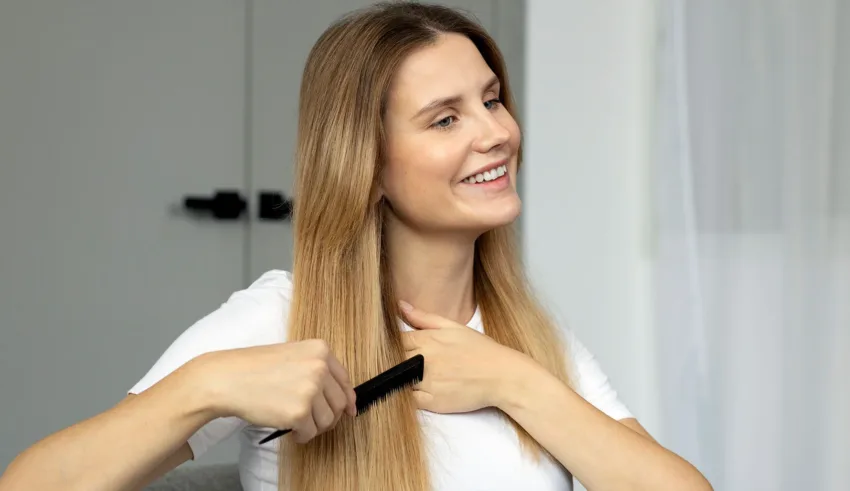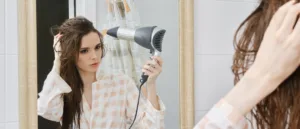
Are your hair care beliefs preventing you from achieving the luscious hair you’ve always dreamed of? In a world awash with advice, it’s essential to separate fact from fiction. In this article from The Dermo Lab, we will discuss false hair care myths and reveal the secrets to unlocking your hair’s true potential. From miracle cures to ancient legends, join us as we debunk these captivating but often misleading stories and discover the true path to hair care. It’s time to say goodbye to myths and hello to hair care that works wonders!
Myth 1: Frequent haircuts accelerate hair growth
One of the most persistent hair care myths is the belief that frequent trimming accelerates hair growth. The logic behind this myth seems simple: cutting hair regularly eliminates split ends and promotes healthier growth. However, this is not entirely true.
Hair grows at the level of the scalp, and cutting the ends does not affect the speed of root growth. Cutting your hair may help keep it healthy by preventing split ends from creeping up the hair shaft, but it doesn’t affect the speed of growth. To promote hair growth, opt for a healthy diet, proper scalp care and minimize damage caused by heat and chemical treatments.
Myth 2: Brushing your hair 100 times a day keeps it healthy
The idea of brushing hair vigorously to stimulate blood circulation and distribute natural oils is a romantic notion that has been perpetuated for generations. While brushing hair can help distribute oils and remove tangles, the 100-stroke rule is excessive and can actually cause damage.
Excessive brushing can lead to hair breakage and unnecessary tension on your strands. A few strokes with the right type of brush are all you need for daily maintenance. In fact, excessive brushing can be counterproductive, especially for people with fine or fragile hair. It’s essential to choose the right brush for your hair type and use it wisely to preserve your hair’s health.
Myth 3: You have to wash your hair every day
The belief that you need to wash your hair every day to keep it clean and healthy is another persistent myth. In reality, daily washing can strip your hair of its natural oils, leaving it dry and more susceptible to damage. Washing frequency should be adapted to your hair type and lifestyle.
People with oily scalps may need to wash their hair more frequently, while those with dry or curly hair can space out washes. In general, 2-3 days is a good starting point for most hair types. Use a sulfate-free shampoo that suits your specific hair needs.
Myth 4: Rinsing with cold water makes hair shinier
This myth suggests that rinsing hair with cold water after a shower will make it shinier. While it’s true that cold water can temporarily smooth the hair cuticle, it doesn’t provide lasting shine.
Hair cuticles, the outermost layer of the hair shaft, are flattened when cold. Hot water can open these cuticles, allowing hair to be better cleansed and cared for. To keep hair healthy and shiny, use the right hair care products.
Myth 5: Products can fix split ends
It’s common to want to find a product that can magically repair split ends. However, once your hair is split, the only effective solution is to cut off the damaged ends. No product can truly repair the fork in the hair shaft. Products labeled as “split-end repairers” may temporarily seal split ends and make them smoother, but this effect is temporary and doesn’t address the underlying damage.
Myth 6: Air-drying is healthier than blow-drying
There’s a widespread myth that air-drying is the healthier option while blow-drying damages hair. While heat can indeed damage hair, the truth is a little more nuanced.
Air-drying may be a healthier option, but it’s not for everyone, especially those with thick or long hair. When hair is left wet for long periods, it can become damaged and break. Blow-drying, when done correctly with the right heat protection products, can be a safe and effective way to dry hair. It is essential to use a lower heat setting, maintain a safe distance from the hair, and apply a heat protection product before drying.
Myth 7: More shampoo means cleaner hair
It’s a common misconception that using more shampoo means cleaner hair. However, too much shampoo can strip your hair of its natural oils, leaving it dry and brittle. In most cases, a small amount of shampoo is sufficient for effective cleansing.
Myth 8: Removing one gray hair causes others to grow
It’s a common belief that pulling out a single gray hair causes other gray hairs to grow in its place. However, this myth is not true. Gray hair is primarily the result of the natural aging process and genetics, and pulling out one hair does not influence the color of neighboring hairs.
Myth 9: Natural oils are always safe hair care solutions
While natural oils like coconut oil, olive oil, and argan oil can be great additions to your hair care routine, it’s a myth to assume that they’re always safe and beneficial. The use of oils should be adapted to your hair type and concerns.
Myth 10: You can permanently repair damaged hair
The notion that extremely damaged hair can be completely repaired is a persistent but false belief. Hair is made up of a protein called keratin, and once it’s damaged, it’s impossible to restore it to its original state. Products can help improve the appearance and manageability of damaged hair, but the damage itself remains.
The key to healthier hair is prevention and maintenance. Regular trimming, using heat protection products, and avoiding aggressive chemical treatments are key strategies. Patience and a consistent hair care routine are essential for gradually improving the condition of damaged hair.
Conclusion
Armed with the right knowledge, you can now tailor your hair care routine to your specific needs and hair type, rather than relying on outdated beliefs. Remember, there’s no one-size-fits-all solution when it comes to hair care, and it’s important to understand your hair’s unique needs.
By abandoning these myths and adopting evidence-based practices, you can achieve and maintain the beautiful, luscious locks you’ve always wanted. Your hair deserves the best care, and that starts with knowing the truth. Say goodbye to fairytales and hello to hair care that works wonders!









